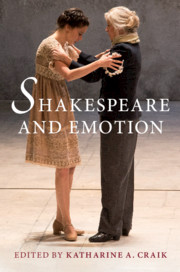Book contents
- Shakespeare and Emotion
- Shakespeare and Emotion
- Copyright page
- Contents
- Figures
- Contributors
- Acknowledgements
- Note on Text
- Introduction
- Part I Contexts
- Part II Emotions
- Chapter 13 Fear
- Chapter 14 Grief
- Chapter 15 Sympathy
- Chapter 16 Shame
- Chapter 17 Anger
- Chapter 18 Pride
- Chapter 19 Happiness
- Chapter 20 Love
- Chapter 21 Nostalgia
- Chapter 22 Wonder
- Chapter 23 Confusion
- Bibliography
- Index
Chapter 22 - Wonder
Pericles, The Tempest, ‘The Phoenix and the Turtle’
from Part II - Emotions
Published online by Cambridge University Press: 01 October 2020
- Shakespeare and Emotion
- Shakespeare and Emotion
- Copyright page
- Contents
- Figures
- Contributors
- Acknowledgements
- Note on Text
- Introduction
- Part I Contexts
- Part II Emotions
- Chapter 13 Fear
- Chapter 14 Grief
- Chapter 15 Sympathy
- Chapter 16 Shame
- Chapter 17 Anger
- Chapter 18 Pride
- Chapter 19 Happiness
- Chapter 20 Love
- Chapter 21 Nostalgia
- Chapter 22 Wonder
- Chapter 23 Confusion
- Bibliography
- Index
Summary
Wonder is a key emotion to Shakespeare’s work as a whole, from first to last. Three principal sites of the evocation of wonder are discussed: in narrative, in character, and in language. Discussion of the first focuses on Shakespeare’s career-long interest in romance narratives of marvel, drawing on both ancient and popular traditions. These traditions inform Shakespeare’s writing from The Comedy of Errors through the last plays. In them marvellous events – especially involving recoveries and reunions – reveal a world unexpected in its amplitude, larger than human knowledge can easily understand. Audiences are encouraged to share this perception of the world-opening possibilities of poetry. Wonder experienced by characters provides an opportunity for audiences to examine closely the mechanics of the affect, and the attempts of persons to negotiate and emerge from it into knowledge. Wonder in language touches on Shakespeare’s characteristic extremity of rhetorical style, particularly his use of figures such as paradox, hyperbole, and catachresis. Altogether, this commitment to wonder reveals Shakespeare as a poet of an unclosed universe – one ever rich in possibility and the unexpected.
Keywords
- Type
- Chapter
- Information
- Shakespeare and Emotion , pp. 317 - 329Publisher: Cambridge University PressPrint publication year: 2020

